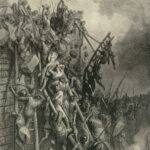Here are some thoughts that I had when I decided to dig deep into John chapter 6:
Previous Readings
Up until this point, whenever I have come to John 6 I’ve focused on the “bread of life” aspects of the text and have merely passed over the more Calvinist sounding verses. There are two reasons for this. First of all, the bread of life passages mean more to me. The second is that bread of life passages are what the section is really about, and Calvinist-sounding texts are really passing statements that Jesus made, so I never really noticed them.
Whenever Calvinists have pointed to these texts, it has always been in isolation, so I almost could see their point. However, in isolation, I could also easily read prevenient grace into the passages as well, so I have never found them convincing.
In summary, up until this point I have found these texts to be vague semblances of Calvinist ideas that are distracting from the grander context of John 6 when focused upon.
Personal Exegesis
Initial Problems
Due to the way that I do exegesis, my first questions of the text were “What is the overall point of this passage? Why is Jesus having this conversation? However does this story fit into the overall narrative of John?” (Actually the overall narrative means even more in John than it does in the other gospels since John flows more than the other gospels.) What I realized was interesting.
The basic point of the passage is to compare the faithlessness of the Jews in the crowd to the faithfulness of the disciples. Basically the difference is that the disciples receive the “Bread of Life” from the Father, while the others do not.
To be honest, this left me in a pickle as far my previous understanding of verse 44. I had always understood this to simply be prevenient grace, but it is clear, from context, that this verse is dealing with one of the very many distinctions between the disciples and the other Jews. Thus, this could not be prevenient grace, since prevenient grace is extended to all. Essentially, the scope of the text is too narrow to apply across the general means of salvation.
But I also didn’t find Calvinism here either. There was nothing in the text that implied regeneration before faith, nor was there anything that identified the drawing as irresistible. Furthermore, there were no text that laid the basis of how this drawing works, or indeed what this drawing actually is. It is merely a passing statement during Jesus’ greater point, which is criticizing the people for not listening. Indeed, I find it rather odd for Jesus to be rebuking them for not listening when they are not being drawn to listen to begin with. That’s like rebuking a deaf person for not listening.
Thus I had a new question: What did this drawing mean?
I also had a second. This whole idea of those being given to Christ from verse 37 also made me wonder. Again, I didn’t think Calvinism. No where does John say that these which are given to Jesus were selected unconditionally. Indeed, nothing is said about a selection process at all! All it says is that there are some given to Jesus.
Clearly my former thoughts did not hold up to the context, yet I found that though Calvinism would answer some of these questions neatly, the text did not imply Calvinism itself, thus defeating it as being a proof-text. After all, if this is a proof-text of Calvinism, then one should be able to extract Calvinism from this. But you can’t, so it’s not. Indeed, the best one could say about it is that it is an obscure text that is hard to understand, and Calvinism has an adequate theory to explain it.
But what did this mean? Does it means that no one is saved unless the Father hands them over to Jesus? And by what manner does the Father decide which ones to give Jesus? And what is the drawing that the text is speaking of?
An Answer from Prayer
While thinking all of this over a couple of days, I suddenly remembered that the language of those being given to Christ was used in His high priestly prayer in John 17. So I turned there to see if I can figure some of this out.
Reading the whole prayer straight through it became very clear to me was that Jesus was contrasting those who has been given to Him from those that were to be saved later on (Vs 20). In other words, you and I are not those ‘given to Him’. Those given to Him were the disciples. Therefore, being given to Jesus is not the normative operation of salvation, but something specific that was happening during Jesus’ earthly ministry.
It is also important from verse 12 that Judas is one of the ones that was given to Jesus. Therefore, although being given to Jesus has clear soteriological implications because of John 6, it cannot be the same thing as unconditional election leading to absolute perseverance, as Calvinists claim it means.
Finding the Brown and White Picture
And no, I do not mean sepia. I was listening to the first debate between Dr. James White and Dr. Michael Brown on Dr. White’s podcast. Dr. White referenced John 6 as one of the best Calvinist proof-texts, though his exegesis had some serious problems (mostly that they contradict what I have stated earlier in this post).
The central problem that I had with what Dr. White said was that he claimed that going to other passages in John (not other passages in the Bible, but other passages in the same book!!!) was bad exegesis. What?! I’m sorry, but that’s is really really foolish, and I don’t say that to be cruel or insulting, because I do respect him, but that is really foolish. I understand that it is poor exegesis to break down Exodus with Romans in mind because Moses did not have Romans in mind when Exodus was being written. But the book of John is a cohesive book! John absolutely had John 12 and 17 in mind when he wrote John 6 (as did Holy Spirit) and it is not only reasonable, but also proper to assume that language he used in one part of his book would mean the same thing if used somewhere else in his book. Has Dr. White never heard of foreshadowing? Has he never watched a movie or read a book where something was introduced and then explained later? It just baffles me how inane that comment is, especially since it is central to interpreting John 6 properly since 6 gives very little to no context to understand what the term “given to” actually means.
Moving beyond that, what Dr. Brown said brought a lot of what I was already thinking into a cohesive thought. If we are to understand that there exists those in Israel who already belonged to God, than it is logical to understand this passage as saying that the Father gave those who belonged to Him to Jesus at this time in His ministry. Furthermore, the entire context of the passage also begins to make sense. Like I said early on Jesus is clearly differentiating between those that follow Him and those that don’t. But when we recognize that there exists those that already belong to God before the coming of Christ, then we recognize that the differentiation is that the disciples were part of the true remnant of Israel, while these were not.
This brings a lot of other passages to light too. For instance, “those that belong to me recognize my voice.” When we understand this as pointing to the Jewish community, we can see that what is going on is that Jesus is saying “you are not following me because you do not follow my Father.” This has nothing to do with the unconditionally of election, but with unity of the Father and the Son, and how the Son is in perfect harmony with the Father’s purpose and people. Those who are truly a part of the Father’s people will recognize the Father in Christ.
Indeed, this also makes Peter’s statement in John 6 all the stronger. After Jesus gives his speech, He turns to the disciples and says “Will you leave also.” Peter replies, “where else shall we go? You have the answers to eternal life.” You see? Peter saw the Father in Jesus and that is why Peter followed Him. And he saw the Father in Jesus because he knew the Father. The crowd did not see the Father in Jesus, because they did not know the Father, and so rejected Jesus simply because He confused them. However, when the disciples were confused, they went to Him to seek deeper understanding.
Drawing Conclusions
As for conclusions on what ‘drawing’ means, I’m having a bit more difficulty with that. There are two other instances where John uses it in this book. One is John 12:32, where Jesus says that He will draw all to Himself (Not “all men”. Not “all kinds of men”. Just “all”) . The other is in John 21 where the disciples draw the fish up from the water. Ironically it was this second one that brought me some insight.
But first, let us compare draw in John 6 with John 12. First, the scope of the drawing in John 6 is particular: it only applies to those who were given to Christ by the Father. Second the scope of John 12 is universal: it uses the word all. Now, does all refer to every person? Maybe, maybe not. There is little context to answer that absolutely. Third, the context of John 6 is referring to Christ being in possession of those of whom He is drawing, yet the context of John 12 is the cross. Thus we must conclude that these two passages are not referring to the same thing.
Therefore, any interpretation that labels both of these things as prevenient grace does not take into account the particularity of John 6, and any interpretation that labels both of these as regenerative grace does not take heed of the scope of John 12. However, we must assume that John is using the term ‘draw’ in a similar fashion. So even though these two texts do not refer to the same action, they do refer to a similar kind of action.
If we consider the idea of drawing referring to the same kind of activity as the disciples drawing up fish with a net, then we can see how this can work. In the case of John 12, it is by the means of the cross that Christ draws all to Himself for judgment. If you note the context of John 12, Christ is talking about taking His rightful place as ruler of the world, by disposing Satan, and bringing the world to judgment. If we think of the meaning of this in terms of what this means for humankind, it would mean that Christ is subjecting all under His authority. Thus, by drawing all, He is capturing all within His rulership.
We bring this to John 6, Jesus is talking about being given the remnant of the people of Israel. Thus, in the last day, those who have been given to Him, He will take up with Him to glory. Thus, we have a picture of drawing: bringing them up.
What I do not see here is the idea of regeneration, which is ultimately what Calvinists argue. In John 6, I see drawing referring to the Father drawing them into His possession before giving them to Christ. The resistibility of this isn’t mentioned at all.
This said, though I am rather confident that I am right regarding John 6 on this issue, I still have some doubts as to whether I am understanding John 12 appropriately.
Please visit here for original post and comments






Leave a Reply